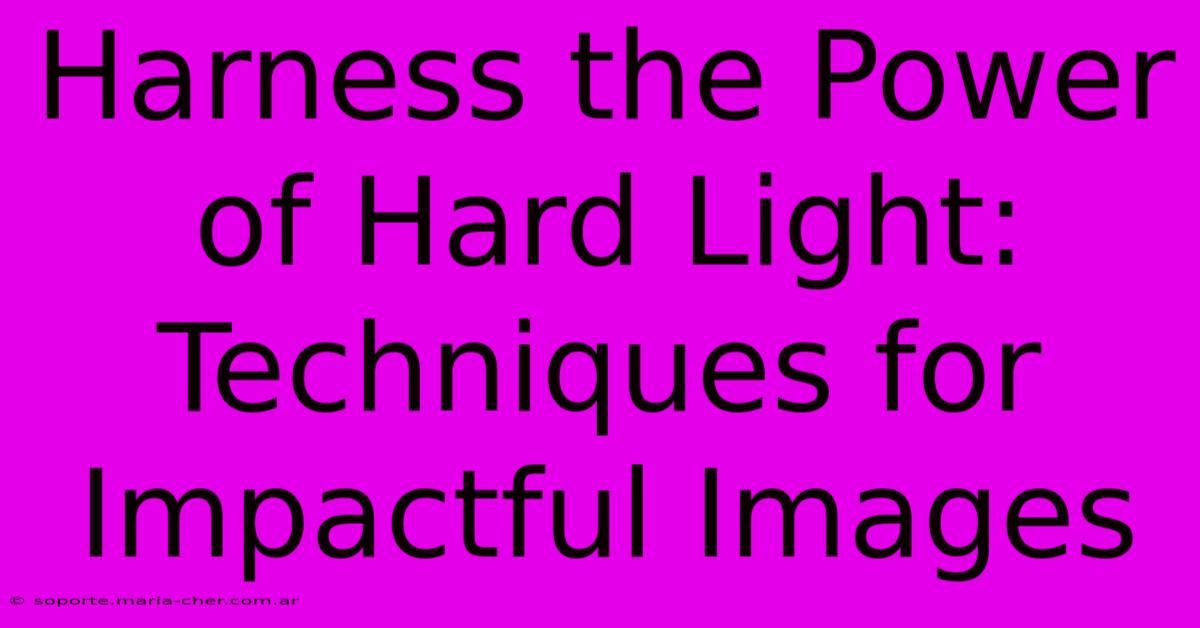Harness The Power Of Hard Light: Techniques For Impactful Images

Table of Contents
Harness the Power of Hard Light: Techniques for Impactful Images
Hard light, characterized by its strong, directional nature and defined shadows, offers photographers a powerful tool for creating dramatic and impactful images. Unlike soft light's gentle diffusion, hard light sculpts the subject, revealing texture, form, and detail with striking clarity. Mastering hard light techniques allows you to elevate your photography to a new level of visual storytelling. This guide explores effective strategies for harnessing the power of hard light and achieving stunning results.
Understanding Hard Light's Characteristics
Hard light sources are small relative to the subject, resulting in intense highlights and deep, sharply defined shadows. Think of the midday sun on a clear day, or a small, bare bulb close to your subject. These characteristics can be both advantageous and challenging, depending on your creative goals. Understanding these nuances is crucial for successful hard light photography.
Advantages of Hard Light:
- Dramatic Contrast: Hard light creates strong contrast between light and shadow, leading to a visually arresting image with a high-impact feel.
- Texture Emphasis: The sharp shadows highlight surface textures, adding depth and realism to your photographs.
- Defined Forms: Hard light clearly defines the shape and form of the subject, making it stand out against the background.
- Strong Mood and Atmosphere: Hard light can create a sense of drama, intensity, or even mystery, depending on the subject and composition.
Challenges of Hard Light:
- Harsh Shadows: Deep shadows can obscure details and create areas of undesirable darkness.
- High Contrast Issues: The extreme contrast can lead to blown-out highlights (pure white areas lacking detail) and blocked shadows (pure black areas lacking detail).
- Difficult Exposure: Achieving proper exposure can be tricky due to the wide range of tones present in the scene.
Techniques for Mastering Hard Light Photography
Employing the right techniques is key to successfully harnessing the power of hard light. Here are some effective strategies:
1. Control Your Light Source
- Time of Day: The midday sun is the most common source of hard light. However, the harshness can be mitigated by shooting during the "golden hour" (shortly after sunrise or before sunset) for a softer, warmer hard light.
- Light Modifiers: While hard light is naturally directional, using tools like reflectors or diffusers can soften the light partially, controlling the harshness to your liking. Experiment with different modifiers to find the perfect balance.
- Artificial Light Sources: Studio strobes or speedlights can be precisely controlled for consistent hard light, allowing greater manipulation of shadow placement and intensity.
2. Strategic Positioning and Composition
- Side Lighting: Position the light source to one side of your subject to create dramatic side lighting, revealing texture and form.
- Backlighting: Backlighting can create a silhouette effect, enhancing the mood and mystery.
- Rim Lighting: Carefully placed light from behind the subject can create a thin highlight along the edges, separating the subject from the background.
- Consider Your Background: A simple background works best with hard light to avoid distractions from the sharply defined subject.
3. Mastering Exposure and Post-Processing
- Exposure Compensation: Use exposure compensation to brighten shadows or darken highlights to maintain detail in both areas.
- HDR (High Dynamic Range) Photography: Combine multiple exposures with different exposures to capture detail in both the highlights and shadows.
- Post-Processing Techniques: Tools like Adobe Lightroom or Photoshop allow you to fine-tune contrast, recover shadow details, and refine highlights for optimal results. Dodging and burning can selectively lighten or darken areas of your image to achieve a polished look.
Examples of Hard Light in Photography
Hard light is incredibly versatile. You'll find its effective use in various genres:
- Portrait Photography: Creating dramatic portraits with defined facial features.
- Product Photography: Showcasing product texture and detail.
- Architectural Photography: Highlighting building structures and architectural details.
- Landscape Photography: Capturing the drama of a harsh landscape.
Conclusion: Embrace the Drama
Hard light photography presents a rewarding challenge. By understanding its properties, employing effective techniques, and mastering post-processing, you can create striking and unforgettable images. Embrace the drama, and let hard light enhance your creative vision. Remember to experiment and practice to develop your skills and find your unique style within this powerful lighting technique.

Thank you for visiting our website wich cover about Harness The Power Of Hard Light: Techniques For Impactful Images. We hope the information provided has been useful to you. Feel free to contact us if you have any questions or need further assistance. See you next time and dont miss to bookmark.
Featured Posts
-
Omg You Wont Believe What This Email Signature Did To My Inbox
Feb 04, 2025
-
Unveiling Joys Return Inside Out 2 Poster Unveils
Feb 04, 2025
-
Transform Your Email Persona 10 Signature Quotes That Reflect Your Brilliance
Feb 04, 2025
-
Unveiling Natures Emerald Aisle Discover The Majestic World Of Palm Greenery
Feb 04, 2025
-
Unleashing The Cta The Key To Seamless Desktop User Experiences
Feb 04, 2025
